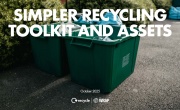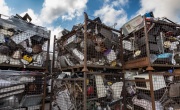Rethinking the EU’s plastic recycling plan
Anders Wijkman, Chairman of Climate-KIC, and Novamont CEO Catia Bastioli say standards and separate collections rather than simply ‘recyclable’ materials will create a circular plastics economy.

That is, indeed, welcome. But the snail pace so far in terms of implementation has been embarrassing. The Commission is working towards a goal that all plastic packaging on the EU market will be recyclable by 2030.
In 2015, with more than 20 million tonnes per year of plastics in the EU, packaging represented almost 40 per cent. Scarcely 26 per cent of all plastics are recycled in Europe.
The question is what to do about it? Would recycling the conventional way really be a good solution?
Plastics composition and properties are diverse, which makes a comprehensive recycling of their residues basically impossible. The best we can hope for is that enhanced recycling of everything from plastic water bottles to yoghurt pots will be ‘downcycled’ into other low-value products.
In this situation we must ask if the effort to make all plastic packaging recyclable would really be feasible. Most of the plastics will still end up in an incinerator or in a landfill, shifting the environmental burden to the atmosphere or to the soil.
What we need instead are standards – to limit the number of different plastic qualities – and separate collection systems for the main qualities. In essence this means we have to rethink the whole system.
Calls for further increasing EU recycling rates for plastics should therefore be based on an assessment of the complete plastics value chain with the aim to improve eco-design for certified plastics in priority applications, increase demand and thereby collection of certified recycled plastics, and mandatory schemes for separate collection of biowaste.
The ideal toolbox to redesign a sustainable plastics value chain are standardisation and clear policy objectives. The imperative to ‘recycle more’ will be effective only if industry, governments and advocacy groups join forces to build a ‘plastics system that works’. The implication would be the changing of an economic model that thrives on wasteful products and packaging and the development of a portfolio of products, preferably based on locally available resources, that would aim at closing the loops.
More than two-thirds of the 96 million tonnes of biowaste generated in the EU are still landfilled, resulting in a grave loss of resources. It is estimated that a EU policy aiming at zero biowaste to landfill – or incineration – would generate about 50 million tonnes of CO2 savings; tens of billions of Euros in investments in territorial development and tens of thousands of jobs.
There is a range of new integrated technologies ready for scale-up if only the EU did play its role to promote models by developing relevant standards, advocating for proper GPP (Green Public Procurement) implementation by member states and providing a regulatory environment to boost specific bioplastics applications.
Anders Wijkman is co-president of the Club of Rome and Chairman of the Swedish Association of Recycling Industries.
Catia Bastioli serves as CEO at bioplastics producer Novamont, and is Chairwoman at TERNA, Italy’s electricity transmission grid operator. 









